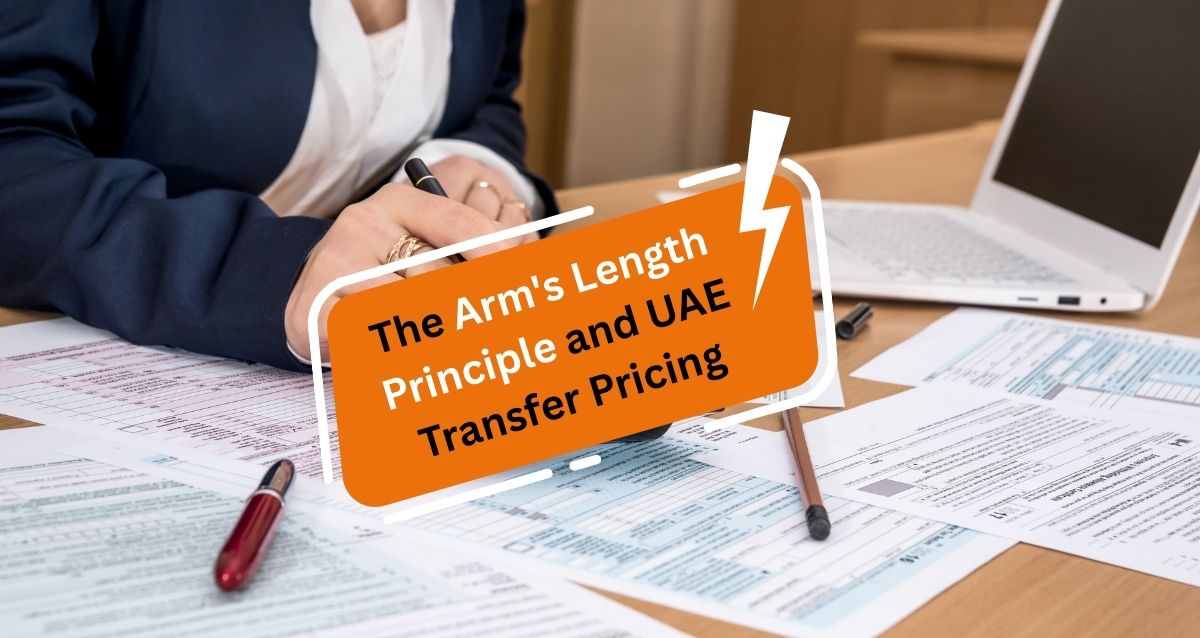The Arm’s Length Principle Explained: A Deep Dive into the Cornerstone of UAE Transfer Pricing
The Arm's Length Principle (ALP) is the single and the powerful concept on which the foundation of UAE’s new Corporate Tax (CT) is built upon. If you have a business operating in UAE having related party transactions, understanding this Principle is not just a compliance task for you, it is the key element for managing your tax obligations, mitigating risks and ensuring the financial health of your business operations.
The logic behind this Arm’s Length Principle is straightforward, while the phrase might sound complex. This blog will take you deeply into ALP, which is explaining on what exactly this principle, why it matters and how the businesses in UAE can apply it accurately on their intercompany transactions.
What Exactly is the Arm's Length Principle?
The Arm's Length Principle is a global standard used for transfer pricing. It mandates that the transactions between Related Parties and Connected Persons must be conducted in the same price and under the same conditions as if they were between two independent, unrelated entities in an open market.
Imagine a simple scenario:
➣ Without the ALP: A manufacturing company operating in UAE sells their products to its subsidiary which is in another country for a nominal price of AED 1 per unit aiming to shift profits to a lower tax jurisdiction.
➣ With the ALP: The same UAE company must sell those products to its subsidiary at the same price it would have sell them to an independent, third-party distributor. Say, for AED 100 per unit. This ensures that the UAE entity records its share of profit fairly, which is then subject to Corporate Tax.
The ALP's core objective is to prevent profit shifting and ensure that each entity within a multinational group earns a return commensurate with their performance, the assets it uses, and the risks it is taking. This principle is explicitly embedded in Article 34 of the UAE's Corporate Tax Law, making it a legal requirement for all qualifying businesses.
The Five Transfer Pricing Methods to Apply the ALP
To prove that your intercompany transactions are at Arm’s length Price, it requires more than just assumption. UAE, under with the Guidelines of OECD Transfer Pricing, implemented five specific methods to determine an arm's length price. These methods are categorized into two types: Traditional Transaction Methods and Transactional Profit Methods
1. Traditional Transaction Methods
These methods focus on comparing the price or gross margin of a properly controlled transaction with that of a comparable uncontrolled transaction. They are generally considered as the most direct and reliable methods when there exist good comparability.
➣ Comparable Uncontrolled Price (CUP) Method: This is the most direct and preferred method for determining ALP. It generally compares the price charged in a controlled transaction with that of the price charged in a comparable uncontrolled transaction.
Example: A company based in UAE sells specialized equipment to both an independent customer and to a related entity. The price they charged to the independent customer is AED 500,000 which will serves as the arm's length price for the sale with related entity.
➣ Resale Price Method (RPM): This method is mostly suitable for distributors or resellers who is purchasing products from their related party and reselling them to an independent third party without making any significant value addition. This method works on reverse basis, i.e Starts calculation with the resale price
Example: A distributor in UAE buys clothes from its parent company which is abroad (i.e. Their Related party) for a certain price and sells them to a local retailer at a price of AED 1000. By reviewing the gross profit margins of comparable independent distributors in the UAE (say 15%), the arm’s length purchase price from the parent company can be calculated at (AED 1000 minus 15% profit margin, which is AED 150, which gives an arm’s length price of AED 850).
➣ Cost Plus Method (CPM): This method is mostly used by manufacturers or service providers. Under this method, calculations starts with the costs incurred by the supplier in a controlled transaction and adds a market based gross profit mark up to determine the arm’s length price
Example: A company in UAE provides IT services to its related entity. By examining the gross profit mark-ups of comparable independent IT service providers (say at 15%), the UAE Company adds this mark-up to its own costs to arrive at an arm’s length price for this IT services.
2. Transactional Profit Methods
These methods are mostly used when traditional methods are not easily applicable or reliable. This focus on the profitability of the transaction rather than the price only.
➣ Transactional Net Margin Method (TNMM): This is the most frequently used method in practice. It compares the net profit margin of a controlled transaction with that of the net profit margin earned by a comparable independent company. Compared to traditional methods, it is less sensitive to minor transactional differences.
Example: The net profit margin of the UAE entity from it’s operations with a related party is 8%. On the basis of the benchmarking studies conducted with data of comparable independent companies, it was find that their average net profit margin is between 7&% and 10%. Since the entity’s net profit margin falls within the arm’s length range, the pricing is deemed compliant under ALP
➣ Profit Split Method (PSM): This is used for the transactions which are highly integrated and complex where two or more related parties contribute valuable, non-routine assets (like unique intellectual property) that are difficult to segregates. The total combined profits from these transactions is divided between the parties based on the relative value of their respective contributions.
Example: A UAE company develops the hardware for a new innovation of technology, while the related entity which is in another country develops the software. The total profit from the sale of the final product(IP) is divided among the two entities based on their respective contributions to the intellectual property and the overall value chain.
Documentation: The Evidence of Your Compliance
The application of the ALP is only half of the battle, the rest lies on proving the same. As per UAE’s transfer pricing regulations, it is mandatory for certain businesses to prepare and maintain proper documentation to support their transfer pricing positions. This includes:
➣ The Master File: This includes a high level overview of the entire multinational group’s business, operations, overall transfer pricing policies and global allocation of income and economic activity
➣ The Local File: This is more detailed document specific to the concerned UAE entity, providing a comprehensive analysis of its controlled transactions and the application of the ALP rules.
➣ The Transfer Pricing Disclosure Form: It is an annual form required to be submitted along with the Corporate Tax return, providing a high-level summary of your related party transactions.
For FTA, your documentation serves the primary evidence that your intercompany transactions are conducted at arm’s length Price. A failure to provide this required documentations, or providing incomplete or inaccurate information, can lead to complex tax adjustments and significant penalties.
How Flying Colour Tax Consultant Can Help
A specialized expertise is required to analyze the complexity of the Arm’s length Principle and selecting the most appropriate method for your business. We at Flying Colour Tax Consultants, will guide the businesses like yours on complying with transfer Pricing framework
Our services are specifically designed to help you in every aspect of ALP compliance, including:
➺ Method Selection: We guide you in choosing the transfer pricing method which is most appropriate for each of your unique controlled related party transactions.
➺ Benchmarking Studies: We conduct detailed benchmarking studies using reliable databases from market to provide solid evidence proving your transactions are at arm’s length price.
➺ Documentation Preparation: We assist in preparing all the necessary documentation for ALP Compliances like the Master File, Local File, and Disclosure Form etc. Ensuring all the documentations is accurate, reliable and ready for audit.
➺ Risk Mitigation: We help you to proactively identify and address potential compliance risks under ALP and thereby safeguarding your business from penalties and tax disputes.
Don’t leave your transfer pricing to chance. By partnering with our experts, you can build a transparent and compliant framework that not only meets regulatory requirements but also supports the long-term strategic success of your business in the UAE.
To learn more about The Arm's Length Principle and UAE Transfer Pricing, book a free consultation with one of the Flyingcolour team advisors.
Disclaimer: The information provided in this blog is based on our understanding of current tax laws and regulations. It is intended for general informational purposes only and does not constitute professional tax advice, consultation, or representation. The author and publisher are not responsible for any errors or omissions, or for any actions taken based on the information contained in this blog.


